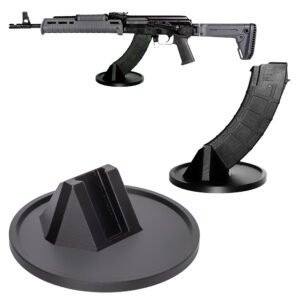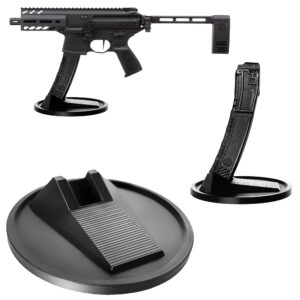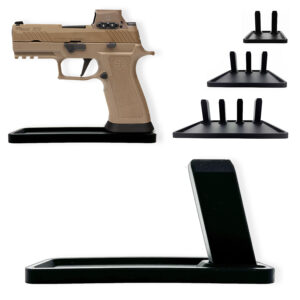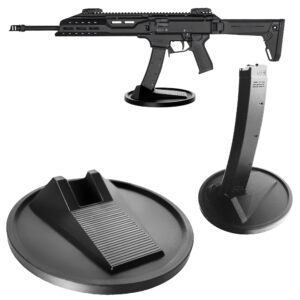
Categories:
The AR-10 platform, a formidable and versatile gun widely appreciated by sports shooters, hunters, and military personnel, owes its operational efficiency to several crucial components. Among these, the charging handle plays a pivotal role. The charging handle on an AR-10 is not an ostentatious piece of hardware, yet it is fundamental for the rifle’s operation. Its principal function is to manually cycle the rifle’s bolt, a task that is essential for both loading cartridges into the chamber and clearing jams or malfunctions that might occur during use.
At first glance, the charging handle might seem like a straightforward component, yet it is engineered with precision to ensure reliable performance. When the shooter pulls the charging handle back, the motion draws the bolt carrier group (BCG) to the rear of the receiver. This action achieves several key functions: it cocks the hammer, seats a round in the chamber when loading, and allows for the inspection or clearing of the chamber.
This manual control over the bolt allows the shooter to effectively manage the status of the gun in various operational scenarios.
The process of clearing jams or malfunctions is particularly important to understand. Firing mechanisms, while generally reliable, are not infallible, and encountering a jammed cartridge or a misfeed is not uncommon. In such instances, the charging handle becomes a crucial tool. By pulling it back, the operator can eject the problematic cartridge and cycle a new one from the magazine, ensuring the gun is quickly returned to a functional state.
The ease with which this can be done, without disassembling parts or using additional tools, speaks to the ergonomic and practical design of the AR-10 platform.
Furthermore, the charging handle offers an added layer of flexibility. The standard AR-10 charging handle is located centrally at the rear of the upper receiver, allowing ambidextrous use. However, there are numerous aftermarket options available that cater to specific user preferences, including extended handles for easier grip or ambidextrous handles for left or right-handed operation, further enhancing the rifle’s adaptability.
In the realm of tactical and sporting rifles, where reliability and responsiveness are paramount, the AR-10’s charging handle stands out as a crucial feature. Its role in manually cycling the bolt for loading or clearing jams is indispensable, providing shooters with the confidence and control necessary to maintain optimal performance of their gun.
The charging handle in an AR10 rifle is a pivotal component that plays several crucial roles in the operation of the gun. It is designed to manually cycle the bolt, which is integral for both loading the rifle and clearing jams. The AR10, like its counterpart the AR15, is a gas-operated, semi-automatic rifle, but the charging handle remains an essential feature for ensuring reliable functionality.
When the charging handle is pulled back and released, it initiates the loading process. Pulling the handle retracts the bolt carrier group, enabling the hammer to reset and the bolt to lock into the rear position. Upon releasing the handle, the bolt travels forward, stripping a round from the magazine and chambering it. This action readies the gun for firing, making the charging handle an indispensable tool for preparing the rifle for use.
Aside from loading, the charging handle plays a critical role in correcting malfunctions. In real-world conditions, a variety of issues, such as a failure to feed, double-feed, or stove-pipe jam, can occur. The charging handle allows the shooter to manually clear these malfunctions. For instance, if a shooter experiences a failure to feed, manually cycling the bolt using the charging handle can eject the misfed round and chamber a new one.
Similarly, in cases of double-feed or stove-pipe jams, pulling back the charging handle can expel the offending rounds or casings, clearing the jam and allowing the shooter to resume firing.
Moreover, the charging handle is also instrumental for preliminary safety checks and maintenance procedures. Before disassembling the rifle for cleaning or inspection, cycling the bolt with the charging handle ensures that the gun is unloaded and safe to handle. This action is part of the standard safety protocol that prevents accidental discharges and contributes to safe gun handling practices.
In tactical scenarios, the charging handle can be used for immediate action drills. A skilled user can cycle the bolt rapidly to address malfunctions or reload, minimizing downtime and maintaining operational readiness. This capability underscores the charging handle’s value in both civilian and military applications.
In essence, the charging handle of an AR10 is not merely a mechanical component; it is a multifaceted tool that enhances the rifle’s functionality, reliability, and safety. Whether for loading, addressing jams, or ensuring the gun is clear, the charging handle’s role is indispensable in the effective operation of the AR10 platform.
Manually cycling the bolt of an AR-10 rifle using the charging handle is a fundamental skill for any shooter, whether for loading the gun or clearing a jam. This process entails several straightforward, yet precise steps to ensure safe and effective operation of the weapon. The charging handle, located at the rear of the upper receiver, is the primary mechanism for manually manipulating the bolt.
To begin, always ensure that the rifle is pointed in a safe direction and that your finger is off the trigger. Safety is paramount when handling any gun. If the magazine is not already inserted, do so by positioning the magazine at the base of the magazine well and pushing it firmly into place until it clicks. This ensures that it is properly seated and ready to feed rounds into the chamber.
Grab the charging handle with your dominant hand, typically your right hand if you are right-handed. Your left hand should maintain a firm grip on the pistol grip of the rifle. To cycle the bolt, pull the charging handle straight back. This action draws the bolt carrier group to the rear, compressing the buffer spring within the stock and creating space for a round to be chambered.
Fully retract the charging handle until it cannot go any further. If done properly, you will feel increased resistance as the bolt carrier group moves to the rear.
Once the charging handle is pulled all the way back, release it smoothly and swiftly. Do not ride the charging handle forward; allow it to snap back under the power of the buffer spring. This forceful return of the bolt carrier group ensures that the bolt properly strips a round from the magazine and seats it securely into the chamber. This method guarantees that the rifle is ready to fire when the trigger is pulled.
In the event of a jam, manually cycling the bolt with the charging handle is an effective method to clear the obstruction. With the weapon pointed in a safe direction, retract the charging handle to open the bolt. Inspect the ejection port for any spent casings or live rounds that may be causing the malfunction. Once the obstruction is identified and removed, release the charging handle to chamber a new round.
Practicing this maneuver routinely will help build muscle memory and ensure that operating the AR-10’s charging handle becomes second nature, enhancing both your reliability and safety when handling the rifle.
Loading the AR10 with the charging handle is an essential skill for any shooter, whether they are a novice or a seasoned marksman. The AR10, a versatile and powerful rifle, relies on its charging handle to manually cycle the bolt for various functions, including loading ammunition into the chamber. This mechanical action underscores the significance of understanding the correct procedure for using the charging handle effectively and safely.
To start, it’s crucial to ensure that the gun is pointed in a safe direction and that the shooter’s finger is off the trigger, resting alongside the receiver. Safety always comes first, and these fundamental precautions help prevent accidental discharges. With the gun on safe and the muzzle pointed downrange, the shooter can proceed to load the AR10.
Begin by inserting a loaded magazine into the magazine well, ensuring it locks securely in place. A firm upward push typically does the job, and an audible click will confirm the magazine’s engagement. Once the magazine is correctly seated, the charging handle comes into play. The charging handle on an AR10 is located at the rear of the upper receiver and serves as the manual operation tool to cycle the bolt.
Grasp the charging handle, using the support hand for right-handed shooters or the dominant hand for left-handed shooters, and pull it fully rearward. This action draws the bolt carrier group back, compressing the buffer spring and creating room in the chamber for the first round. At the rearmost point of the charging handle’s travel, release it promptly rather than riding it back forward.
This sudden release allows the buffer spring to propel the bolt carrier group forward with enough force to strip a round from the magazine and chamber it securely. Riding the charging handle forward may hinder the bolt’s momentum, potentially causing feeding issues or failures to chamber.
Once the bolt is fully closed and the round is chambered, the AR10 is ready to fire. The shooter can then disengage the safety and prepare to fire as necessary. Each pull of the trigger will subsequently cycle the bolt automatically, ejecting spent casings and chambering new rounds until the magazine is empty. The proper use of the charging handle for initial loading is fundamental to the reliable operation of the AR10, making it a critical component of the shooting process.
Understanding this procedure enhances both the efficiency and safety of handling such a powerful rifle.
Clearing jams in an AR-10 rifle using the charging handle involves a methodical approach that ensures both safety and functionality. When a jam occurs, it means the cocking mechanism has encountered an obstacle, preventing the rifle from cycling properly. This can be caused by various issues such as a misfed round, an improperly ejected casing, or debris obstructing the bolt’s path.
The charging handle plays a pivotal role in manually cycling the bolt to address these problems.
The process of clearing a jam begins with ensuring the gun is pointed in a safe direction, maintaining strict adherence to gun safety rules. The next step is to engage the magazine release and remove the magazine. This helps to isolate the chamber and can make it easier to diagnose the problem.
With the magazine removed, the shooter should firmly grasp the charging handle, which is located at the top rear of the upper receiver. A strong, decisive movement is required to pull the charging handle back. This action usually helps to extract and eject any problematic round or casing from the chamber. If the bolt seems to be stuck, a forceful and repeated tugging action may be necessary to dislodge the obstruction.
Once the charging handle is pulled completely to the rear, it should be locked in place either using the bolt catch or by simply holding it back manually. The obstruction should then be visible in the ejection port. If a round or casing is still lodged in the chamber or partially ejected, manually removing it with fingers or a suitable tool, such as a multi-tool or a cleaning rod, is the next step.
Occasionally, debris such as dirt or unburnt powder may be the cause of the jam. In such cases, visually inspecting the chamber and bolt carrier group for any obstructions is crucial. Cleaning and lubricating the affected areas can prevent future jams.
After clearing the obstruction, the charging handle should be released, allowing the bolt to move forward and effectively cycle the action. Reinsert the magazine, chamber a fresh round, and ensure normal operation by firing several test rounds in a controlled manner.
Regular maintenance and understanding the functioning of the AR-10 charging handle are key to preventing jams and ensuring the reliability of the rifle during crucial moments. By mastering the charging handle’s use, shooters can efficiently manage and resolve malfunctions, resulting in a more dependable gun.
Ensuring the proper maintenance of your AR10 charging handle is essential for the optimal performance of your gun. A well-maintained charging handle not only aids in manually cycling the bolt for loading or clearing jams, but also contributes to the overall longevity and reliability of your weapon. Start by frequently disassembling your AR10 to perform a detailed inspection of the charging handle.
Dirt, debris, and carbon fouling can accumulate in and around the charging handle, leading to sluggish operation and potential malfunctions during critical moments.
Begin the maintenance process by clearing your gun, ensuring it is unloaded and safe to handle. Remove the upper receiver from the lower receiver, then take out the bolt carrier group. This will give you access to the charging handle. Inspect the charging handle for any visible signs of wear or damage. Pay special attention to the latch, the edges, and the track along which it slides.
Any bent or broken parts should be replaced to avoid malfunction. Check for dirt and debris, which can impede the smooth operation of the charging handle.
Clean the charging handle using appropriate solvents and brushes. Apply solvent to break down any carbon or grime, and use a brush to scrub the surface gently. Make sure to clean the track inside the upper receiver as well, using a cotton swab or a specialized cleaning tool. Once all components are clean, wipe them dry with a microfiber cloth to prevent any moisture from causing rust or corrosion.
Lubrication is another crucial aspect of maintaining your charging handle. Use a high-quality gun lubricant on the charging handle, especially on the latch and the sliding track. A thin layer is typically sufficient; over-lubrication can attract more dust and debris. After applying the lubricant, reassemble the charging handle and bolt carrier group into the upper receiver. Ensure that everything is moving smoothly by manually cycling the charging handle several times.
Periodically, recheck the tightness and alignment of the charging handle. Even though it is a robust part, the repetitive forces exerted on it during operation can lead to loosening or misalignment over time. Keeping a routine maintenance schedule, coupled with occasional in-depth inspections, will ensure your AR10 charging handle operates efficiently. This steadfast care will guarantee that your gun functions flawlessly when you need it most, ultimately enhancing your shooting experience.
Choosing the right charging handle for your AR10 is crucial for ensuring reliable performance and ease of operation, especially when it comes to manually cycling the bolt for loading or clearing jams. This small but significant component impacts how efficiently and comfortably you can manipulate your gun, and therefore deserves careful consideration.
One of the first aspects to consider is the material and construction of the charging handle. You want a handle that is durable enough to withstand the rigors of consistent use, yet lightweight enough not to add unnecessary heft to your rifle. Many high-quality charging handles are made from aircraft-grade aluminum, which provides an optimal balance of strength and weight. Additionally, some charging handles come with a hard anodized finish to increase resistance to wear and corrosion, extending the lifespan of the component.
Another important factor is the design of the latch mechanism. The latch is what engages with the receiver to hold the charging handle in place when not in use. Traditional mil-spec handles have a single-sided latch, which might suffice for standard operations but can be cumbersome in high-stress situations or if you are wearing gloves. Ambidextrous handles, on the other hand, feature latches on both sides, allowing for more versatile and easier manipulation no matter your dominant hand.
This can be particularly beneficial in tactical or defensive scenarios where quick, efficient handling is paramount.
Ergonomics also play a considerable role in choosing the right charging handle. A handle with an extended latch or an enhanced grip surface will make it easier to apply the necessary force to cycle the bolt, especially under adverse conditions such as cold weather or muddy environments. Some charging handles feature oversized or textured latches designed for maximum grip and comfort, minimizing the effort required to clear jams or load the bolt.
Lastly, consider whether you need any specialized functionalities, such as gas-busting features, which are especially valuable if you are running a suppressed AR10. These types of charging handles are designed to redirect gas flow away from the shooter’s face, enhancing comfort and reducing carbon buildup in the upper receiver.
Ultimately, the best charging handle for your AR10 will depend on your specific needs and preferences. Prioritizing durability, latch design, ergonomics, and any additional features tailored to your shooting style will help ensure you choose a component that complements and enhances your gun’s performance.








Colt
Colt M4 Carbine
Colt LE6920
Colt AR-15 A4
Daniel Defense
DDM4 V7
DDM4 V9
DDM4 V11
DDM4 ISR (Integrally Suppressed Rifle)
Smith & Wesson (S&W)
M&P15 Sport II
M&P15 Tactical
M&P15T
Bravo Company Manufacturing (BCM)
BCM Recce-16
BCM Recce-14
BCM MCMR Series
Aero Precision
M4E1 Series
AC-15
AR15 Pistol (Various Configurations)
Ruger
Ruger AR-556
Ruger SR-556
Ruger AR-556 MPR (Multi-Purpose Rifle)
Springfield Armory
Saint Victor
Saint Edge
Saint AR-15
PSA (Palmetto State Armory)
PSA PA-15
PSA AR-V
PSA Jakl (AR Pistol)
FN America
FN 15 Tactical Carbine
FN 15 Patrol
FN 15 DMR
Wilson Combat
Recon Tactical
Super Sniper
Protector Carbine
SIG Sauer
SIG M400 Tread
SIG M400 Elite
SIG M400 SDI
LWRC International
IC DI (Direct Impingement)
IC SPR
IC A5
Bushmaster Guns
XM-15 QRC
Bushmaster MOE
XM-15 Patrolman
Rock River Arms
LAR-15 Entry Tactical
LAR-15 Predator
LAR-15 Elite Comp
Stag Arms
Stag 15 Tactical
Stag 15L (Left-Handed Models)
Stag 15 Valkyrie
Noveske Rifleworks
Noveske Gen 4 N4
Noveske Space Invader (AR Pistol)
Noveske Recon
Anderson Manufacturing
AM-15 Optic Ready
AM-15 M4 Carbine
AM-15 Precision Rifle
Adams Arms
AA-15 Piston Rifle
P2 AARS (Adams Arms Rifle Series)
Black Rain Ordnance
SPEC15 Series
BRO Predator
Fallout 15
Diamondback Guns
DB15 Series
DB15CCMLB
DB15EB
Del-Ton Inc.
DTI-15
Del-Ton Echo 316H
Sierra 316M
Windham Weaponry
Windham SRC
Windham VEX-SS
Windham RMCS-4 (Caliber Conversion System)
Christensen Arms
CA-15 G2
CA-15 Recon
CA-15 Titanium Edition
Patriot Ordnance Factory (POF-USA)
Renegade Plus
P415 Edge
Revolution DI
LaRue Tactical
PredatAR
OBR (Optimized Battle Rifle)
LaRue Stealth 2.0
Battle Arms Development
Workhorse Patrol Carbine
BAD556-LW (Lightweight)
Authority Elite Rifle
Faxon Guns
Ascent AR-15
FX-19 (AR Pistol)
Streamline Ultralight Series
KE Arms
KE-15 SLT (Super Lightweight Tactical)
KE-15 Scout Carbine
Primary Weapons Systems (PWS)
MK1 MOD 2-M
MK116 PRO
MK107 (Piston AR Pistol)
ZEV Technologies
ZEV Core Elite Rifle
ZEV AR15 Billet Rifles
Franklin Armory
BFSIII AR-C1
Militia Model
F17-L (Chambered in .17 WSM)
Seekins Precision
SP15 DMR
NX15 Skeletonized Rifle
Havak Bravo
Aero Precision (Additional Models)
EPC-9 (Pistol Caliber ARs)
VG6 AR Rifles
Barrett Guns
REC7 DI
REC7 Gen II
CMMG
MK4 RCE
Resolute 300
Banshee (AR Pistol)
DPMS Panther Arms
Panther Oracle
Panther LR-308
H&K (Heckler & Koch)
HK MR556A1
HK416 (Military Variant)
Rock Island Armory (Armscor)
VR-80 Tactical AR (Shotgun AR Platform)
Troy Industries
Troy SPC-A3
Troy PAR (Pump Action AR)
Wilson Tactical
Tactical Recon AR
Protector Series
F1 Guns
FDR-15 Skeletonized Rifle
BDRx-15 Series
Juggernaut Tactical
JT-15
JT-10 Precision Rifle
AeroSurplus
Surplus AR-15 Rifles (Budget Models)
Thunder Tactical
AR-15 Basic Carbine
Tactical Builder Sets
Radical Guns
RF-15
Forged AR-Series
Dark Storm Industries
DS-15 Featureless Rifles
DS-10 Typhoon
DRD Tactical
Paratus
Aptus AR Rifles
Bear Creek Arsenal
BCA-15
AR Complete Upper Builds
Aero Survival Rifles (ASI)
ASR Tactical Series
Tactical Edge
WARFIGHTER Series
AR-15 Lightweight Rifles
Lone Star Armory
TX15 DMR
TX15 Carbine
HERA Arms
HERA H7
HERA AR-15 Lower Builds
IWI (Israeli Weapon Industries)
Zion-15
DRD Tactical
Tactical Modular Rifles
Quick-Takedown Rifles
V Seven Weapons
1776 Rifle
Hyperlite Rifle
Core Rifle Systems
Core15 Tac III
Core15 Patrol Rifle
Armalite (Original AR-15 Creator)
M15 Tactical
M15 A4 Carbine
DEF15 (Defensive Sporting Rifle Series)
PSA (Palmetto State Armory Additional Models)
PSAK-47 Hybrid (AR-AK Style Hybrid)
PSA Dagger (Pistol Caliber Configurations)
Odin Works
OTR-15
Odin Recon Rifle
Maxim Defense
MDX-508 PDX (Compact AR Pistol)
MDX-510 Rifle